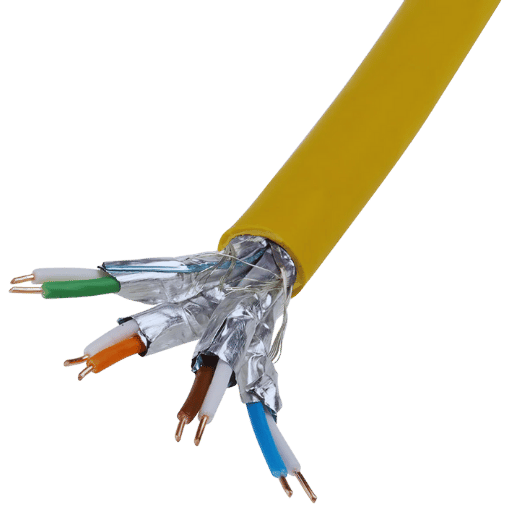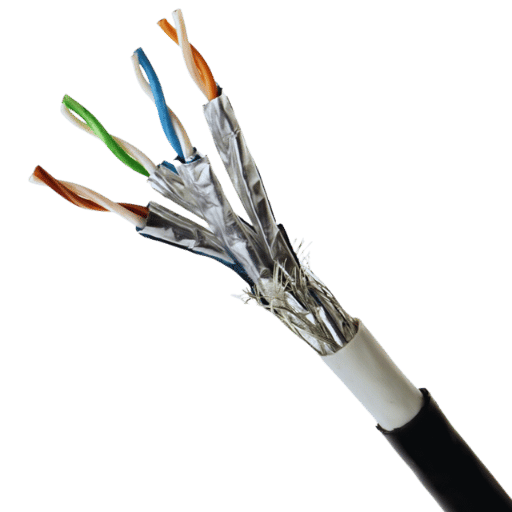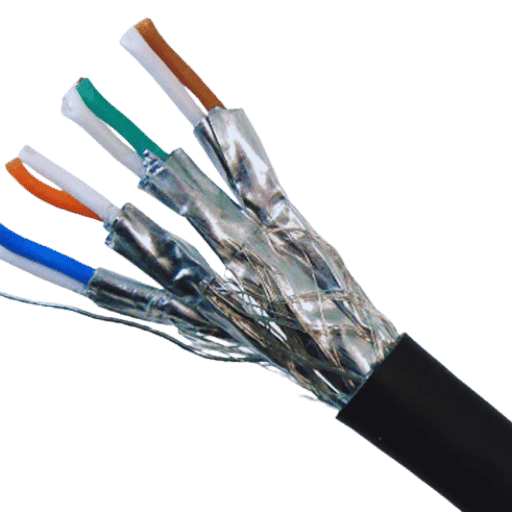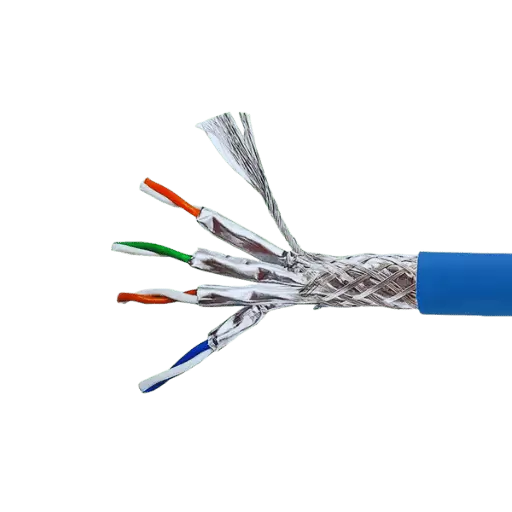In recent years, the world has experienced unprecedented growth associated with the Internet, which means most services fully depend on data. However, for data services to be uninterrupted throughout, the correct ethernet wire must be selected. So this guide takes into consideration all the details associated with the use of Cat7 ethernet wires, which are some of the best in the category when it comes to the performance ratings and the cable shielding technology used. The support for high-speed transmission and the capability of working College X in the most intrusive environment makes cable type 7 the most suitable for any building with a structured cabling system. Coupled with that, this overview is going to look at the characteristics of Cat7 Ethernet, its characteristics, and the fact that it is very different from a lot of the earlier models. These have been explained to all the people who are interested in technology and are working with networks.

The main advantage that Cat7 cables offer over their predecessors is increased shielding and a frequency support of up to 600 MHz, whereas Cat6a supports a maximum of only 500 MHz. This category also makes use of both shielded twisted pair (STP) cables and a combination of a blanket shield, which helps mitigate crosstalk and system noise. Not only does Cat7 Ethernet allow for use in future applications, but it also has the ability to work with all of the older generations of ethernet cables. One of the most interesting aspects of Cat 7 Ethernet is its ability to transmit data at speeds of 10 Gbps over distances of 100 meters. All of these things mark significant advancement for the category in the context of its predecessors.
The advancement in cable technology from ‘Cat5e’ to ‘Cat7’ has dramatically increased the rate of data transfer. Category 5 enhanced, commonly known as Cat5e, incorporated the transfer rate of 1 Gbps and the portability over its 100 Mbps predecessor, known as Cat5. Moving on to Cat6, the data rate increased to 10 Gbps over a small distance with improved shielding material. This was further enabled with the introduction of Cat6a, which could transfer information over a distance of 100 meters while maintaining a data rate of 10 Gbps. The evolution continues in the family of cables, with Cat7 able to achieve 10 Gbps with less amount of noise interference while extending the same distance with the enhancement of the shielding material, which reaches 600 megahertz. With each generation, more bandwidth has been the core focus, eliminating noise interference while transferring information faster.
The Cat7 Ethernet cable is designed with features requiring high-speed network operation:
The Cat7 ethernet cables have replaced the Cat6 ethernet cables, as they have drastically improved speed and capacity features. Most Cat6 cables are designed to operate with bandwidths of up to 250 Mhz and even support a maximum of 1 gigabit per second data transfer over a distance of 100 meters. Contrary to this scenario, Cat7 functions a lot better over the same distance of 100 meters as it also supports a frequency range of 600 MHz and a data carrying speed of up to 10 gigabits per second. There is, however, a noticeable improvement in the construction and usage of Cat7 cables, such as the lighter gauge and allied shielding technology, which minimizes electromagnetic interference and crosstalk.
The Cat7 ethernet cables have a wide array of benefits for enterprise networking or centers that rely heavily on data transfer, as they minimize lag while also increasing throughput speeds. However, it is important to note that Cat6 cables can still be employed in households or small businesses without major problems. Even though it is not as effective in protecting against damage as the Cat7 cables, it is a better option because it meets the ISO IEC 11801 standards, which allow it to transfer data at high speeds. As a result, it would be best to consider these factors: the requirement of the network, data transfer speeds, and the budget before choosing between the two ethernet cables.

With the two-fold electromagnetic interference (EMI) and crosstalk mitigation, Cat7 ethernet cables have an electric signal quality that is quite high. Adequate layers of shielding, i.e., individual pair shielding and an overall cable shield, cover for greater isolation from external noise, and therefore, signal integrity is maintained in areas with high interference, such as industrial areas or densely cabled data centers. This design enhances the cable’s performance parameters, ensuring dependable and satisfying transfer of high-frequency data. Constant and high-quality data transmission is essential for applications that require robust and efficiently working network systems.
Cat7 Ethernet adaptation’s shielded twisted pairs are pivotal in enhancing data transmission quality by minimizing crosstalk and electromagnetic interference (EMI). The use of foils encasing each wire pair within the cable ensures that interference caused by electromagnetic sources or other cable pairs is eliminated. This form of double shielding not only maintains the quality of the signal but also improves data transfer rates and decreases post-transmission error rates. This makes the Cat7 cables ideal in environments where there is a high level of EMI, ensuring strong and consistent network delivery.

The RJ45 connector, while being one of the most extensively used connectors in Ethernet networks’ circuitry, is also found to have a basic functional and structural compatibility with the GG45 connector used in the Cat7 networks. GG45 was intended to replace the RJ45 connectors since it could support bandwidths of up to 600 MHz as opposed to the normal 250 MHz bandwidth supported by the RJ45 connectors for the Cat6 applications. This capacity is enhanced by the addition of four extra conductors, which are used only when GG45 plugs and jacks are mated together, which increases the bandwidth available for data transmission.
It is important to note, however, that even though GG45 has better performance skills, it is able to maintain some of the functional characteristics associated with the RJ45 connectors, which makes it possible for networks to scale up to better performance without having to replace all the current installation of RJ45 cables. In terms of performance data, when a GG45 is used with an RJ45 plug, networks are still capable of performing under set standards for category 6A. This implies that as the businesses are gradually switching to Cat7 cabling, the network systems can still use the current RJ45 cabling systems, drastically reducing the costs associated with improving the network system.
In any network construction, it is important to take into account factors such as
These considerations will help your network management achieve the desired performance levels. Reliability and efficiency are some of the modern-day best practices, as suggested by highly rated-professional sources.
The use of snagless RJ45 connectors has shown to be a positive development by enhancing the durability and ease of installation in areas where Cat 7 Ethernet cables are being used. This is apparent considering that these connectors have a molded boot, which ensures that the latch is incorporated during the installation and does not cause damage. The bandwidth performance term is relevant considering that the frequency supported by Cat 7 cables is up to 600 MHz, and it allows for networking of high speeds of up to 10 Gbps. Particularly if the countering forces in the form of Cat 7 cables inherent in German technologies that involve a crosstalk and cable malfunction are present, then data transmission performance would be greatly enhanced, with or without snagless connectors in a dense network environment. The use of high quality snagless connectors is now underscored by recent reports since constant studies have been carried out to show the importance of kabling and termination on network reliability, it foster efficiency increases of up to 15% relative to non-snagless options. This approach is consistent with good practice of network management by ensuring that a comprehensive and sustainable project structure is put in place.

The above recommendations are meant to ensure that the performance of the Cat 7 cables deployed in the house works in conjunction with the other components of equipment to form a fast and efficient network throughout the house.

The use of Cat 7 cables has several benefits within a data center environment. To begin with, they are capable of supporting even higher frequencies up to 600 MHz, which allows for greater bandwidth than the previous cable categories. This helps in improving both the speed of data transmission as well as its reliability. This is important, considering that the data centers operate in demanding environments. Secondly, Cat 7 cables are better fabricated with enhanced overall shielding of each twisted pair, which in turn significantly lowers the chances of crosstalk and external interference, thus assuring the data economy over a longer distance. In the end, one of their most amazing features is the ability to support 10 Gbps over 100 meters, which makes them ideal for usage in data centers where large sets of data must be transferred quickly.
In a data center environment, to promote efficient use of Cat 7 shielded Ethernet cables, it’s imperative to give consideration to installation standards that would enhance performance. First and foremost, everyone should make sure that the correct GG45 connectors, which allow the resilient Cat 7 cables to be put to use with minimum metal shielding and at high frequencies, are properly installed on the ends of the cables. This should improve the cables’ potential, considering that this would reduce signal loss and minimize risks of electromagnetism, which usually interferes with operations. Also, anybody routing cables should use proper practices, as putting too much strain or bending the cables can affect the signals passing through them. This is where cable structures and HVAC conduits come in since they help reduce the risk of physical damage to the cables and maintain their efficiency. There should also be frequent inspections to ensure that those systems are functioning in the required parameters and that any problems are dealt with early. Overall, these practices establish a strong framework ready to cater to the growing demand of modern data centers, which require fast and efficient networks.
A: A Category 7 is basically a type of ethernet cable that can transfer data at 10 gigabits per second over a distance of 100 meters. Additionally, it incorporates a 600 MHz bandwidth feature and is appropriate for places where speed is of the utmost importance.
A: A Cat 7 shielded ethernet cable is significantly superior to Cat 5e and Cat 6 in the sense that it provides better shielding, which eliminates crosstalk and interference; this feature is ideal for high-speed networks and places susceptible to electromagnetic interference.
A: Some of the benefits of selecting a Cat 7 patch cable include improved shielding, a greater bandwidth of 600 MHz, enhanced support for gigabit ethernet and a ten-gigabit ethernet, as well as significantly more reliability in both domestic and commercial network setups.
A: This is a yes, as a Cat 7 ethernet cable can be linked to a router, and thus, a wired connection is set up, which ensures speed and stability for data transfer within the network.
A: The cable assemblies assemble networks with a standard wiring interface such as RJ45; they are permanently terminated at both ends with the interface connectors, therefore providing convenience in usage, standard network interfacing, and cable management.
A: Yes, retractable Cat 7 Ethernet cables are available which are useful for transient connections since their length can be adjusted to minimize slack and are easy to coil when not in use.
A: In the case of Cat 7 cables, as pure bare copper is used, it enhances the overall fabric and cable strength and performance as it conducts higher current with lower signal loss than its alternatives.
A: Although Cat 7 cables do not support HDMI connections, they can be used with converters or extenders that bridge the HDMI and ethernet protocols.
A: The abbreviation 26AWG concerns wire sizes in Cat 7 cables. The 5.7 mm diameter 26AWG cable, which has thicker wire, provides good resistance properties to ensure less signal degradation, enabling reliable transfer of high-speed data.